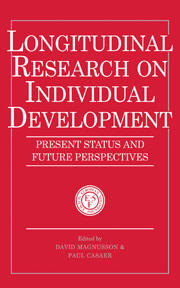Book contents
- Frontmatter
- Contents
- List of principal contributors
- Foreword
- Preface
- 1 Human ontogeny: a longitudinal perspective
- 2 Genes, experience and development
- 3 The human brain and longitudinal research in human development
- 4 Longitudinal research and a biology of human brain development and behaviour
- 5 Cognitive, social and emotional development
- 6 Developmental psychopathology: some historical and current perspectives
- 7 Developmental psychopathology as a research perspective
- 8 Longitudinal research on human aging: the power of combining real-time, microgenetic and simulation approaches
- 9 Development, aging and control: empirical and theoretical issues
- 10 Some methodological issues in longitudinal research: looking ahead
- Index
9 - Development, aging and control: empirical and theoretical issues
Published online by Cambridge University Press: 22 March 2010
- Frontmatter
- Contents
- List of principal contributors
- Foreword
- Preface
- 1 Human ontogeny: a longitudinal perspective
- 2 Genes, experience and development
- 3 The human brain and longitudinal research in human development
- 4 Longitudinal research and a biology of human brain development and behaviour
- 5 Cognitive, social and emotional development
- 6 Developmental psychopathology: some historical and current perspectives
- 7 Developmental psychopathology as a research perspective
- 8 Longitudinal research on human aging: the power of combining real-time, microgenetic and simulation approaches
- 9 Development, aging and control: empirical and theoretical issues
- 10 Some methodological issues in longitudinal research: looking ahead
- Index
Summary
During the last two or three decades, growing resources have been invested in large-scale research projects on adult development and aging (for overviews, see Deeg, 1989; Migdal, Abeles & Sherrod, 1981; Schaie, 1983; Thomae, 1987). This research has documented the broad range and variability of developmental patterns in middle and later adulthood, but it still gives only a fragmentary picture of the underlying dynamics of developmental change in middle and later adulthood. Recent claims emphasizing modifyability, contextual specifity, lack of connectivity and discontinuity of development (cf. Gergen, 1980; Brim & Kagan, 1980) may be seen not only as propositions about the fundamental nature of development but also as symptoms of theoretical perplexity. It is true that simplistic notions of stability and ordered change in adult development are largely discredited by the bulk of evidence. Nevertheless, we should be aware that difficulties in rinding order and coherence may result from theoretical deficiencies rather than reflect a fundamental feature of development itself.
Related to these points, it has to be noted that, even with the most refined longitudinal or sequential designs we do not capture developmental laws, but, at best, regularities in need of theoretical explanation. Developmental researchers should not be content with simply documenting patterns of continuity and change, but inquire more deeply into the regulative processes and generative mechanisms on historical, social, personal as well as physical or biological levels that bring about, maintain, or forestall continuity and change across the life span (cf. Baltes, 1987; Dannefer & Perlmutter, 1990).
- Type
- Chapter
- Information
- Longitudinal Research on Individual DevelopmentPresent Status and Future Perspectives, pp. 194 - 216Publisher: Cambridge University PressPrint publication year: 1993
- 2
- Cited by



